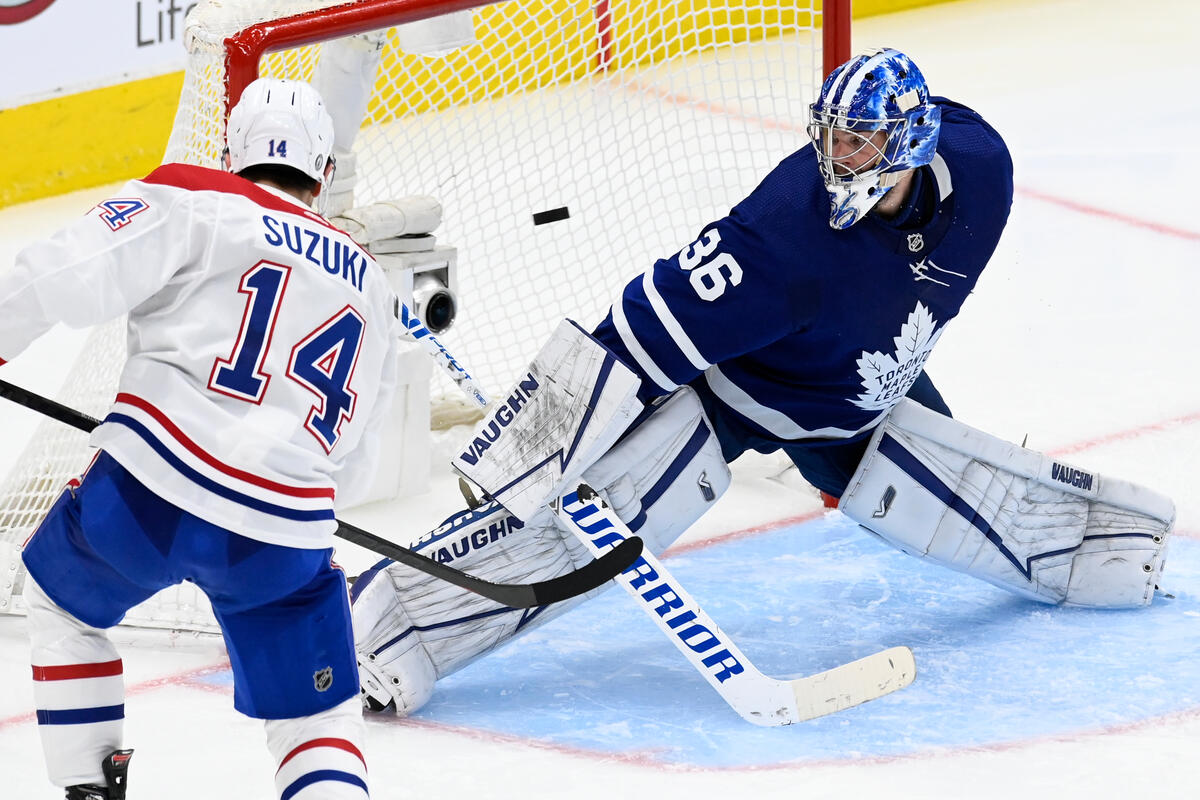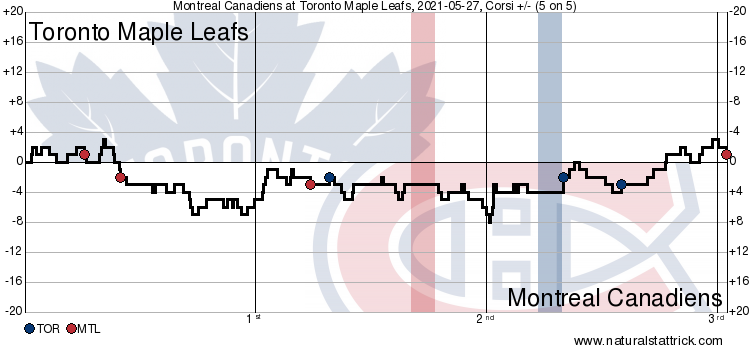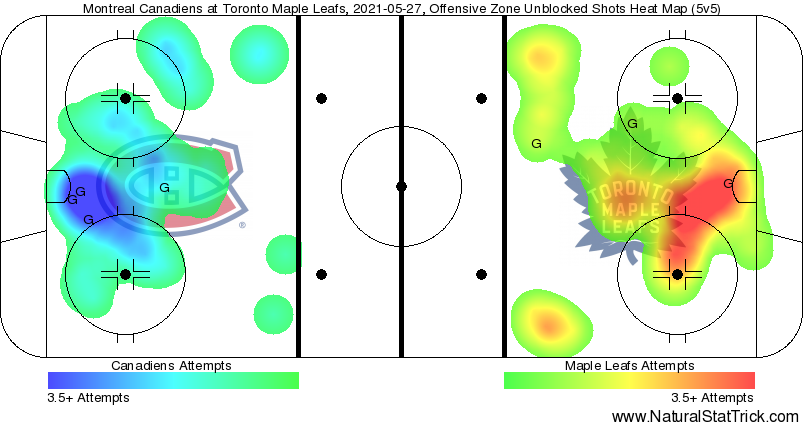The hardest thing to do is put a team away to end their season.
Montreal came out tonight looking crisper, more aggressive on the forecheck, and they were able to create offense like we really haven’t seen so far.
The Leafs were also creating — seemingly at will at times — but Carey Price was fantastic in this one. They finally managed to break through, and they actually came all the way back from 3-0 down. We all know how it ended, though.
There are a lot of positives the Leafs can build on in this one, and a few things they need to clean up, but they are still leading this series and have another chance to end it coming up in a few days.
Your game in 10:
1. There was a hectic pace to the start of this game, with both teams coming out and trading chances. The Habs created a mad scramble in front of Jack Campbell that they couldn’t finish off, Wayne Simmonds hit the post, and Joel Armia capitalized on a Rasmus Sandin turnover to finally score the opening goal.
The Leafs came out looking to push for offense, but their overall play was a little loose, and the Habs made them pay. In the first nine minutes of the game, the Habs put nine shots on net and scored two goals. Before their second goal, Jeff Petry just missed the top corner when he skated in all alone. There was some uncharacteristic pushing of the play and scrambling by Leafs.
After the 2-0 goal, there was a shift where Justin Holl had the puck and both forward lines were changing. As we all know by now, a staple of Sheldon Keefe teams is holding the puck, circling back, going d-to-d, and completing the change while maintaining pressure. Instead, Holl just flipped it up the ice to nobody for a turnover. We haven’t seen that kind of thing from the Leafs all season.
2. In Game 1, after Rasmus Sandin was on for a few goals against, I noted that at 5v5, they are kind of tempting fate by breaking up what has been a rock-solid pairing for them in Travis Dermott – Zach Bogosian. Of course, Sandin responded with a really strong game, so it helped settle down the conversation.
In Game 4, Dermott played a really solid game. Justin Bourne actually clipped all of his touches, which helps demonstrate just how effective he was with the puck on his stick. Sandin has more upside because of what he can do on the power play and offensively in general, but he basically has to be good on the PP to make this decision worthwhile — Dermott is just a little more experienced and steadier in the overall run of play at 5v5.
Sandin played just over four minutes in the first period, and the coaching staff started mixing the pairings with Sandin as the odd man out towards the end of the period. Obviously, in the second period, Sandin committed the turnover that led to the 3-0 goal. He barely played after that.
There’s a real discussion to be had here for the team throughout the playoffs – power play and upside, or steadier 5v5 play?
3. At 3-0, if the coaching staff had any confidence whatsoever in Frederik Andersen, I think there’s a very real chance we would’ve seen them make the switch. The Leafs weren’t playing terribly – they were creating chances – and on at least one of the goals, you wish the Leafs had gotten a save (if we’re honest, more than one of them).
I’m not suggesting that they should have pulled the plug, but they could have. It would have been a reasonable move — if for no other reason than to shake up the team in a game that did not feel right. But Sheldon Keefe left him in, and I think that speaks volumes about how they feel about both goalies.
Later on in the period, Campbell hung in and made a huge save on Toffoli on a mini-breakaway to keep the game within reach at 3-1. From there, he shut the door the rest of the way in regulation.
4. Carey Price made a number of huge saves throughout the first period — none bigger than the massive one on William Nylander, who was all alone against him at the end of the first. When the other goalie is pulling off those kinds of feats and the opposition is going down the ice and scoring, a team needs its stars to step up and stop the bleeding.
To the credit of the Leafs’ top line, they did just that. They poured it on and scored to make it 3-1. While it was nice to see them produce, it was more than a little unnerving to see Marner lose the handle untouched when in all alone, looking like he had little intention to shoot. Marner has had a few of those in this series. At some point, you actually have to shoot it yourself and make the other team pay. It worked out this time, though.
Hyman swipes at the loose puck with bodies in the crease. 3-1 #LeafsForever pic.twitter.com/6tAcT4M6WE
— Maple Leafs Hotstove (@LeafsNews) May 28, 2021
Later in the period, Marner made a nice slap pass to a pinching TJ Brodie, almost resulting in another goal for that line. To start the third, Zach Hyman broke in on a clear breakaway but couldn’t put it home.
5. Not only blending the defense pairings, Sheldon Keefe was also shuffling the forwards around. Notably, he was moving William Nylander around, including a shift with Auston Matthews and Zach Hyman late in the second to try to jump-start some offense. Nylander was their most dangerous player in the game through the first few periods (a mini breakaway after the 2v1 toe drag, almost connecting with Marner backdoor on another 2v1, a one-timer in the slot, and another chance off the rush that he shot just wide).
The coaching staff did look to reward Nylander more than usual, but with that said, he was still fourth among forwards in time on ice through two periods. Interestingly, it is the player who is playing a little less who looks fresher and more dangerous shift-to-shift compared to the top line that gets heavy minutes and has shifts in which they look tired at times.
Of note: The Leafs’ fourth line played very little in this one. They were all under 10 minutes through regulation, and I thought it was deserved. This was their worst game of the series (and to be clear, the fourth line tonight was Joe Thornton – Adam Brooks – Jason Spezza).
6. In the third period, when the Leafs went to a power play down two, William Nylander didn’t start on the top unit. Neither did Rasmus Sandin, as they went with Morgan Rielly, likely due to his 5v5 play to that point (and again, if he’s not contributing on the power play, Travis Dermott is far steadier at 5v5).
Nylander did come out for the power play with the second unit, and who had the best chance on the power play? William Nylander. After the man advantage ended, he picked up a point anyway on the continuation of the play as Jake Muzzin scored on a bomb through traffic.
In different circumstances, Nylander’s lack of ice time would be a massive story (16:36 in regulation tonight), especially with the way he’s scoring and playing overall in the series. I get that the Leafs have the big line — and they are always going to get their minutes — but on average, I don’t think anyone would argue that Hyman should be playing roughly 2.5 minutes per game more at 5v5 and Marner 3.5 minutes per game more at evens (both also play more on the power play per game than him, too). Neither guy has played their best in this series.
Nylander has, though. For good measure, he picked up another point on the second Muzzin goal. He leads the team in points so far this playoff.
7. With their season on the line, the Habs went all-in on their top guys and put the fate of their team in their hands. Their bottom two defensemen literally did not take a shift together – not sure I’ve ever seen that before – and their top four defensemen all played 20+ minutes through regulation, with Weber and Chiarot playing over 26 in regulation alone.
Up front, the Habs really leaned on rolling their lines other than Eric Staal (he played about three fewer minutes than the next lowest forward). Through two periods, Auston Matthews played over five minutes head-to-head against Suzuki and Danault. The Canadiens leaned on the Suzuki line to give them good minutes against the Matthews and Kerfoot lines – a tough task. Suzuki’s linemate Tyler Toffoli has not scored in the series.
8. Quickly — do you know who leads Leafs defensemen in even-strength points over the past two seasons?
It’s Jake Muzzin. He plays against the other team’s best night after night. He leads their penalty kill. He closes games when they have the lead. He closes periods when the game is tight. He’s an all-around stud.
While I was happy that the team scored, I was extra happy that it resulted in Muzzin getting some much-deserved recognition — he often falls under the radar. Rielly’s overall production, Holl’s emergence, and the new signing in Brodie playing well all seem to get more attention in the general discourse, but for me Muzzin is their best defender. He just quietly goes about his business.
Muzzin even had the crafty stick interference on the Habs defender before scoring the tying goal. I didn’t think he had that in him. My favourite play of his, though, came when the score was tied 3-3 and the Habs were making a little push.
Muzzin absolutely erased Nick Suzuki behind the net. Because he dropped Suzuki, he had a little extra time to make a play with the puck when it was rimmed around. With the boards taken away on either side, he calmly hit his partner Holl in the middle of the ice for a clean breakout. That’s excellent hockey.
9. One of the lazier, more frustrating narratives from the Columbus series is that the Leafs simply got goalie’d and that was that. You have to make life difficult for goalies and push through it — usually by driving the net hard and creating off the cycle instead of the rush.
This game was an excellent example. Price, fantastic throughout the night, was more or less stopping everything that he could see. How did the Leafs score three to tie the game? A mad scramble in front with Hyman winning a battle and getting the puck in by the skin of his teeth, a point shot through traffic and in, and a Leaf driving the net off the rush and tipping the puck.
The Leafs generated all sorts of 2v1s and breakaways, but that wasn’t how they scored. This wasn’t Matthews or Nylander ripping the puck cleanly by the goalie (which they can) – these were dirty, muck-it-up goals, generally speaking. You need that to fight through fantastic goaltending.
Muzzin blasts one home as the PP expires. 3-2 #LeafsForever pic.twitter.com/dElXl1vMQI
— Maple Leafs Hotstove (@LeafsNews) May 28, 2021
Muzzin tips in Galchenyuk's shot. 3-3 #LeafsForever pic.twitter.com/MTEvUXuOKS
— Maple Leafs Hotstove (@LeafsNews) May 28, 2021
10. You have to take the good with the bad when it comes to Alex Galchenyuk. That was a stunningly bad play to make at any time, ever, let alone in sudden-death overtime. I’m not really sure what else to say. You simply can’t do that.
You would have expected the Leafs to come out flying in overtime with all the momentum behind them, and yet it was the Habs who were the aggressor early. They buried to put it away.
I picked Leafs in six to start this series. Quite frankly, they just never seem to do anything easy — ever. The pressure will ratchet up a bit heading into Game 6.
Leafs versus Habs on a Saturday night in Montreal, with 2,500 fans in attendance at the Bell Centre, and a second kick at the can to send the Habs packing. See you then.



































![New Leaf Anthony Stolarz on the opportunity in Toronto: “In Florida, I knew my role as a backup… Now, [Joseph Woll] and I are competing for starts… As a goalie, that’s all you can ask for” Anthony Stolarz, Stanley Cup win, now Maple Leaf](https://mapleleafshotstove.com/wp-content/uploads/2024/07/anthony-stolarz-sc-100x70.jpg)
